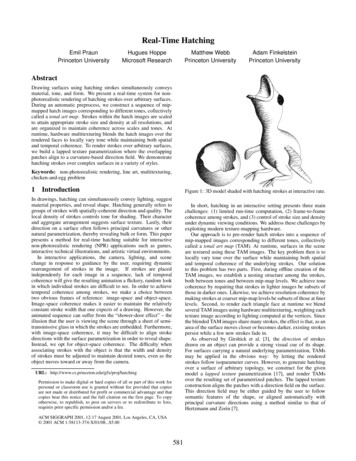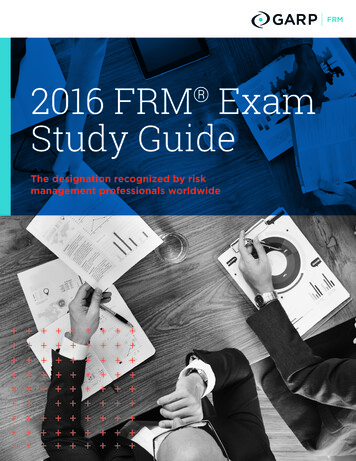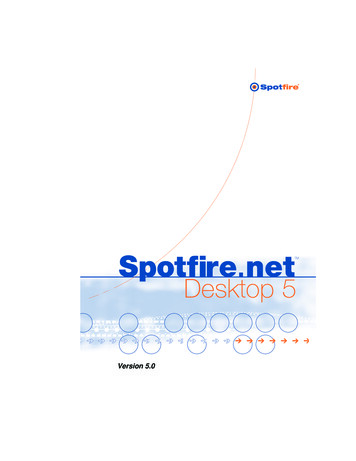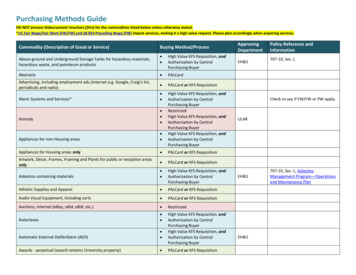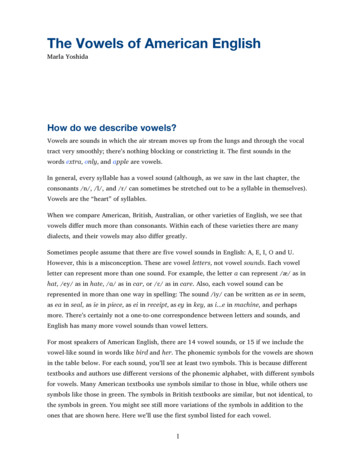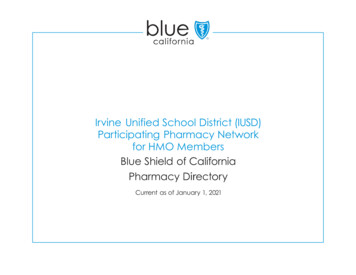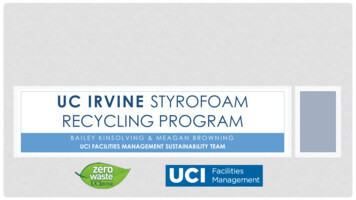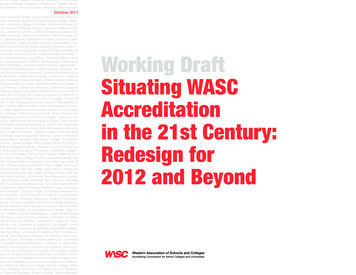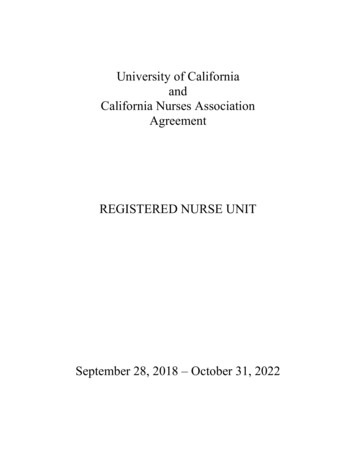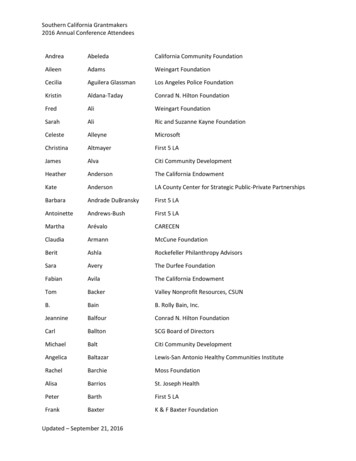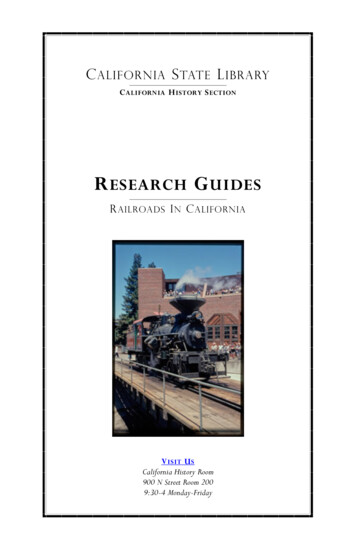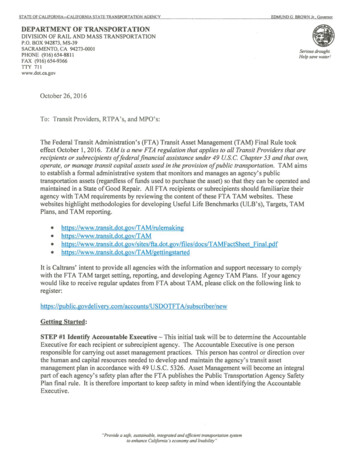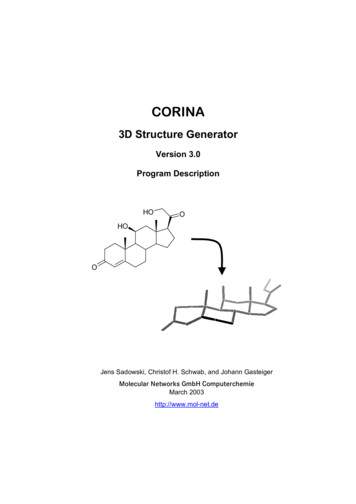
Transcription
CORINA3D Structure GeneratorVersion 3.0Program DescriptionHOOHOOJens Sadowski, Christof H. Schwab, and Johann GasteigerMolecular Networks GmbH ComputerchemieMarch 2003http://www.mol-net.de
Molecular Networks GmbHComputerchemieNägelsbachstr. 2591052 ErlangenGermanyPhone: 49-(0)9131-815668Fax: 49-(0)9131-815669Email: info@mol-net.deWWW: www.mol-net.deThis document is copyright 2003 by Molecular Networks GmbH Computerchemie. All rightsreserved. Except as permitted under the terms of the Software Licensing Agreement of MolecularNetworks GmbH Computerchemie, no part of this publication may be reproduced or distributed inany form or by any means or stored in a database retrieval system without the prior writtenpermission of Molecular Networks GmbH Computerchemie.The software described in this document is furnished under a license and may be used and copiedonly in accordance with the terms of such license.CORINA is a registered trademark in the Federal Republic of Germany. Other product names andcompany names may be trademarks or registered trademarks of their respective owners, in theFederal Republic of Germany and other countries. All rights reserved.
ContentsContents1Program Installation11.1New Installation11.2Program Updates32Problems and Help!43Release Notes53.1CORINA (Full Version)3.2CORINA-F (Restricted Version)5114Getting Started125Program Use14675.1Synopsis145.2Options14CORINA: Automatic Generation of High-Quality 3D Molecular Models246.1Introduction246.2Program Scope246.3The Core System246.4The Challenge: Large Rings266.5Another Challenge: Metal Complexes276.6Evaluation of 3D Structure Generators Using 639 X-Ray Structures296.7Comparison of CONCORD and CORINA using 25,017 X-ray Structures32File Formats and Interfaces347.1MDL Structural Data File (SDF)347.2SMILES Linear Notation367.3SYBYL File Formats367.4Brookhaven Protein Data Bank Format (PDB)377.5MacroModel Structure File Format387.6Maestro File Format387.7Gasteiger Cleartext Format (CTX)387.8Interface between CORINA and FlexX39
Contents89Stereochemical Information408.12D Coding of Stereochemical Information408.2Addition of Missing Stereodescriptors428.3Generation of Stereoisomers44Conformational Analysis of Ring Sysytems for Flexible Search Purposes479.1Generation of Multiple Ring Conformations479.2Handling of Pyramidal Ring Nitrogen Atoms489.3Handling of Molecules Having More Than One Ring System499.4Multiple Ring Conformations in 3D Database Searches4910 Error Messages5310.1 General Errors5310.2 Input File Format Errors5410.3 Stereo Errors5710.4 Errors in the Generation of 3D Coordinates5711 Warning Messages5911.1 Warnings Related to Stereochemistry5911.2 Warnings in the Generation of 3D Coordinates5912 Acknowledgements6113 References6214 Report Form67
Program Installation1Program InstallationSince verion 2.6 CORINA is distributed on a CD-ROM, which contains the executablefile(s) of CORINA, this program description in PDF format, and some example files ofstructure information (see section 4 on page 12).The CD-ROM contains an ISO9660 file system and, thus, is readable by all commonUNIX systems as well as by Microsoft Windows (win32) based platforms. The followingdirectories and files are common for all hardware platforms.name of directorydescriptionname of file(s)examplesexample files for structuredata (ASCII)example.ctxmanualthis program description inPDF formatexample.sdfcorina30manual.pdfPlease copy the example files example.ctx and example.ctx into your home directory.The program description corina30manual.pdf can be viewed and printed with a PDFdocument viewer, e.g. Adobe Acrobat Reader (http://www.adobe.com/acrobat).In addition, the CD-ROM contains at least one the following directories, where theexecutable files of CORINA for the various hardware platforms reside.name of directoryexecutable file of CORINA forname of fileirix65SGI workstations, IRIX 6.5corina.sgilinux22 redhatx86 Linux workstations, Kernel 2.2,distribution by RedHat (7.0)corina.lnxlinux24 redhatx86 Linux workstations, Kernel 2.4,distribution by RedHat (8.0)corina.lnxlinux24 susex86 Linux workstations, Kernel 2.4,distribution by SuSE (7.x)corina.lnxsolaris26Sun SPARC stations, Solaris 2.6corina.sunsolaris8Sun SPARC stations, Solaris8corina.suntru64DEC AlphaStations, Tru64 (OSF1)corina.decwin32Microsoft Windows platforms(win32: NT4/95/98/2000/XP)corina.exe1
Program Installation1.1New Installation1.1.1UNIX Systems (SGI, Sun SPARC, x86 Linux, DEC AlphaStations)1) Create a subdirectory, e.g., corina (for system administrators when installingsoftware locally, e.g. /usr/local/bin/corina).2) Copy the executable file of CORINA corina.sgi/sun/lnx/dec from the CD-ROM tothe subdirectory corina and rename the file corina. sgi/sun/lnx/dec to corina.Please note: corina.sgi/sun/lnx/dec is a binary file.3) Add the corina subdirectory name to the environment variable PATH in your.login or .cshrc files (.profile or .bashrc).1.1.2Microsoft Windows Platforms (win32: NT4/95/98/2000/XP)The directory win32 on the CD-ROM contains the win32 executable file.1) Create a subdirectory, e.g., corina (for system administrators when installing thesoftware locally, e.g. X:\programs\corina).2) Copy the file corina.exe from the CD-ROM to the subdirectory corina. Pleasenote: corina.exe is a binary file.3) Add the corina executable file (corina.exe) and the path where the programresides (e.g. X:\programs\ corina) to your environment variables of your systemsettings (variable: corina; value: X:\programs\ corina).2
Program Installation1.2Program Updates1) Before installing the new version, please copy the old executable andconfiguration files to a new directory, e.g. corinaxxx (xxx old-version-number,e.g., corina24).2) According to the hardware platform install the new version following theinstructions given in section 1.1 on page 2.3) Please note: Since CORINA version 2.4, the data files stdval.ctx and rings.ctxare no longer part of the distribution. All data has been included in the binary fileof CORINA (see section 3.1.6)3
Program Installation2Problems and Help!If you have any difficulties with the installation of CORINA or if any problems occurwhile running CORINA, please send all your inquiries to the following address:Molecular Networks GmbH ComputerchemieNägelsbachstr. 2591052 ErlangenGermanyor contact us by email support@mol-net.de,or by Fax 49-(0)9131-815669.Please include your input file, the output file, and the CORINA trace file corina.trcgenerated by CORINA on an MS/DOS diskette (3½") or send it to us by email. Thesefiles will help us to analyze the problem; if your system displays any error messages,please add them to your report. Thank you!You can also use the report form at the end of this manual.4
Release Notes33.1Release NotesCORINA (Full Version)3.1.1Version 1.6CORINA version 1.6 represents a substantial improvement of version 1.5. Both thequality of the results became higher and the program became more flexible. There arefive major changes in version 1.6 compared to version 1.5.1) The input file format SMILES linear notation was added [1].2) The output file formats SYBYL MOL/MOL2 [2] and the Brookhaven ProteinDatabank PDB [3] were added.3) The algorithm, which refines atom overlap and close contacts was improved byimplementing of a set of rules obtained from a statistical analysis of theconformational preferences of open-chain portions in small molecule crystalstructures contained in the Cambridge Structural Datafile (CSD) [4], [5].4) A substantial speed-up of almost a factor of 2 was achieved by optimizing thethe algorithm.5) The command line options now follow the UNIX command syntax standard.The quality and speed improvements are illustrated in detail in section 6.6 on page 29of this manual. A side-effect of the quality improvements is of course that the resulting3D structures for a number of structural classes might have changed.The changes in the command syntax might cause some portability inconveniences forthe user but gave more flexibility for the addition of new options as, e.g., the new inputand output file specifications. The old options are no longer valid—the program exitswith an error message when recognizing the use of the old syntax.3.1.2Version 1.7CORINA version 1.7 was tailored especially to the database business:1) The two new driver options -d flapn and sc were added for generating multiplering conformations.2) The additional PDB output options -o pdbludi and pdbludilabel allow thegeneration of fragments for databases interfacing to the de novo-designprogram Ludi [6].An exhaustive study on the effect of multiple ring conformations on the performance offlexible 3D pharmacophor searches was performed (see section 9 on page 47).5
Release Notes3.1.3Version 2.0CORINA 2.0 is now able to interact with the ligand docking program FlexX [7] as aconformer generator for ring systems (see section 7.8 on page 39). Thus, CORINA ringconformations can be used for flexible ligand docking into a receptor pocket. Changeswere mainly made concerning the file format interfaces and in the ring conformationoptions.1) Two new input file formats SYBYL MOL/MOL2 [2] (-i t mol and mol2) asrequired by FlexX were added.2) A number of new options were introduced for ring conformations (-d de,timeout and flexx) for tailoring the results for FlexX.3.1.4Version 2.1The following changes and improvements were made:1) The SMILES interface was made more stable (many thanks to the people atOxford Molecular and Dr. Peter Ertl, Novartis for useful hints).2) Three new options -d ow, amide, and -i sdfict related to the handling ofstereochemical information for MDL SDFiles [8] were added (see section 5.2 onpage 14).3) The most important change concerns the handling of the configuration of amidebonds. In earlier versions, the configuration (cis or trans) was taken from the 2Ddrawing in the input file. This behavior must now be switched on explicitly. Bydefault, now the most suitable configuration is taken—in most cases trans.Thus, cases with unexpected cis amides will be no longer generated.3.1.5Version 2.3The following changes and improvements were made:1) A new option -d no3d allows to use CORINA as a file format converter for thesupported file formats without generating 3D coordinates.2) The FlexX interface, the SMILES interpreter and the MDL SDFile were mademore stable.3) Additional ring conformation patterns for cyclo-octa-1,3-diene were added to thetemplate data file rings.ctx.6
Release Notes3.1.6Version 2.4The following changes and improvements were made:1) The data files stdval.ctx and rings.ctx are now inline–easier installation, lessmistakes with different versions.2) The new option -d 3dst forces the use of a given 3D configuration instead of theatomic stereodescriptors. This might be useful if the stereodescriptors are notspecified properly but the 3D structure is correct.3) The new option -d neu neutralizes formal charges at acids, alcoholates, andbasic nitrogens by adding or removing protons. Often it is useful to have allmolecules of a database in the same protonation state. This option can be usedwith the option -d rs in order to remove counter-ions from salts.4) The new option -d ori orients the generated 3D structure according to themoments of inertia. This might be useful when the structure is directly forwardedto a graphical viewer. The molecule then appears more often in an orientationthat shows as much of it as possible on one sight.5) Some minor problems in the FlexX and the MDL interfaces with no influence onthe 3D generation process were fixed.3.1.7Version 2.6The following improvements and changes were implemented:1) The file format MDL RDFile [8] was added to the read and write functions ofCORINA.2) In order to provide interfaces to the protein crystallographic and NMR programpackages CCP4 [9] and X-PLOR [10] the output file formats CCP4 dictionary fileformat (-o dic), X-PLOR topology (-o top), and X-PLOR parameter file format (-opar) were added. These features allow in conjunction with the additional options-o resnam, typchr, dicid the generation of input files for the CCP4 and X-PLORprogram suites.3) Atoms with isotopic mass are now defined for MDL SDFile, SMILES linear code,and Gasteiger ClearText format [11].4) The SMILES reader and interpreter is now more general: SMILES stringscontaining heteroaromatic rings without explicitly defined hydrogen atoms at thehetero atoms are now tolerated. For example, pyrrole compounds can now beinputted also as the "incorrect" SMILES n1cccc1 according to the SMILESlanguage definition (correct coding: [nH]1cccc1).7
Release Notes5) The SMILES reader now accepts only one SMILES linear code per line. TheSMILES code is expected to be the first string in the line. With the input option -ismilesname, all following strings are interpreted as compound name andcopied into the corresponding field of the output file. Thus, white or blankspaces within the compound name are now allowed.6) Non-element symbols, dummy atom types or groups like X, R, Du, Lp, D, T, and* are defined for the file formats MDL SDFile, SMILES linear code, and SYBYLMOL/MOL2. For SMILES linear code the interpretation of dummy atom types orgroups has to be specified explicitly by using the new input option -i dummies.7) With the new input option -i csdmol2 specific extensions and information inSYBYL MOL/MOL2 input files, which were generated by the CambridgeStructural Database (CSD) software [5], are written to the output file.8) The new output option -o m2l ("mass to label") copies isotopic mass labelsgiven in the input file into the corresponding atom name field in SYBYLMOL/MOL2 files. Atoms without given mass label remain untouched.The atomname has the format symbol mass . If the corresponding atom is a nonelement symbol, the atom name has the format R mass . This can be used tocreate extension points for virtual combinatorial library, e.g., as input files forFlexX.9) The new output option -o mdldb creates the additional data fields MODEL.SOURCE , containing information about the program version ofCORINA, and MODEL.CCRATIO , giving the close contact ratio of theCORINA generated 3D molecular model. This option has been added forcompatibility reasons with databases distributed by MDL Information Systems,Inc.10) The new output option –o noccat switches off the automatic conversion of thecarbon atom in amidinium-like structures ([NH2 ] CN) to the carbo-cation typeSYBYL atom type C.cat (N[C ]N). The conversion to this atom type, which is thedefault, is still strongly recommended.11) The conformational analysis package for small and medium sized ring systemshas been improved: CORINA is now able to generate and to output different ringgeometries for ring systems consisting of up to nine ring atoms. In lowerprogram versions, this was limited to a ring size up to eight atoms.12) The conformational analysis package has been extended to a set of over 900rules to avoide or eliminate close contacts of non-bonded atom pairs in 3Dmolecular models. These rules have been derived from a statistical analysis ofthe conformational preferences of open chain portions in small molecule crystalstructures contained in the Cambridge Structural Database (CSD) [4],[5],[12].8
Release Notes13) The new driver option -d sanpyr allows the generation of pyramidal nitrogenatoms in sulfonamide groups. The default, which is strongly recommended, isthe generation of a planar configuration of the nitrogen atom. The sampling ofthe "out-of-plane" distances of 1216 sulfonamide nitrogen atoms as found in theCambridge Structural Database (CSD) [5] has shown, that the in majority ofcases (901 of 1216 sulfonamides – 74%) an "out-of-plane" distance of less than0.3 Å is exihibited. Thus, the planar configuration is the preferred geometrycompared to the pyramidal configuration.14) The new driver option -d newtypes forces CORINA to generate new atom typesfor the output file by discarding any given input types plus aromaticityinformation. This allows the use of CORINA for, e.g., correct retyping ofaromatic groups in corrupted input records.3.1.8Version 3.0The following improvements, changes, and new features were implemented:1) The functionality of the stereoisomer generator STERGEN [13] has beenintegrated in CORINA. The driver option -d stergen forces CORINA todetermine all stereocenters in a given input structure and to generate the 3Dstructures of all possible, but unique stereoisomers. Configurational isomers attetrahedral coordinated centers as well as at double bonds (cis/trans) areconsidered. Duplicate configurations, such as meso-compounds are identifiedand removed. By default (if the driver option -d stergen is set), a maximumnumber of four stereocenters are processed and a maximum number of 16stereoisomeric compounds are generated. However, the driver options -d mscand msi allow to set a user defined number of stereocenters which should beprocessed (msc value ) and to restrict the total number of generatedstereoisomers (msi value ). Stereocenters which have a definedstereochemistry (stereodescriptor) are also processed, unless the driver option d preserve is set which prevents from processing those centers which have adefined stereochemistry, i.e., a stereodescriptor is given in the input structure.2) In order to provide interfaces to the molecular modeling package MacroModel[14], CORINA now supports the uncompressed MacroModel structure file format(input option -i t mmod) as well as the Maestro file format (input option -it mae) [15] as new input and output file formats.3) In addition, the file format CIF (Crystallographic Information File, -o cif) [16]supported by a variety of crystallographic program packages, the file formatODB (O Database file format, -o odb) [17] to interface to the crystallographicmodeling tool O, and the file format of the NMR structure calculation programDYANA (-o dyana) [18],[19] were added.4) The input option -i expandapo forces CORINA to expand attachment pointsdefined in MDL SDFiles ("M APO" field in the properties block) into 3D space.The attachment points are added as "artificial" atoms to the connection table(both to the atom and bond list) and 3D coordinates are calculated. Dummyatom types are assigned to the "artificial" atoms, i.e. "Du" in SYBYL MOL/MOL29
Release Notesfiles, "*" (first attachment point) and "**" (second attachment point),respectively, and "X" in PDB files. In addition, the atom names of the attachmentpoint atoms are set to "R1" (first attachment point) and "R2" (second attachmentpoint), respectively, in the output file for formats which support atom names(e.g., SYBYL MOL2).5) The combined input and output option -i/-o xelement only has an impact ifdummy atom types ("Du") or element symbols which are unknown SYBYL atomtypes are defined in SYBYL MOL2 input files. The new input option -i xelementforces CORINA to derive–if possible–SYBYL atom types either from the atomnames or from the element symbol, or to interpret element symbols in order tointernally set appropriate atom types for the 3D structure generation process. Bydefault, CORINA then outputs dummy atom types ("Du") for these atoms. Inaddition, the new output option -o xelement allows to write the derived SYBYLatom types or the element symbols ("artificial" SYBYL atom types) to the outputfile. Please use these options carefully and manually check the results, sinceambiguous definitions in the input file might lead to misinterpretations or falseassignment of atom types.6) The new output option -o mdlcompact restricts the number of output fields inthe atom lines of the atom block in MDL SDFiles (RDFiles) to the x-, y-, and zcoordinates, the atom type (symbol), the mass difference, the atom charge, andthe stereochemical atom parity (columns 1 through 7 of the atom block). Allother fields in the atom lines are omitted, since they contain no data which ismandatory for 3D
6 CORINA: Automatic Generation of High-Quality 3D Molecular Models 24 6.1 Introduction 24 6.2 Program Scope 24 6.3 The Core System 24 6.4 The Challenge: Large Rings 26 6.5 Another Challenge: Metal Complexes 27 6.6 Evaluation of 3D Structure Generators Using 639 X-Ray Structures 29 6.7 Comparison of C
